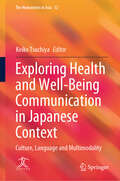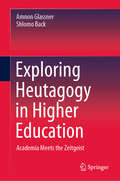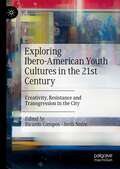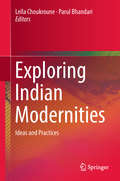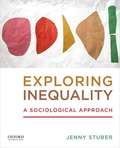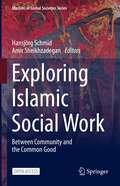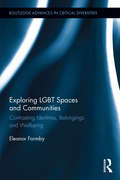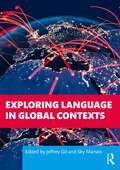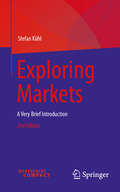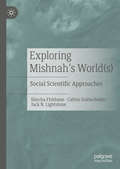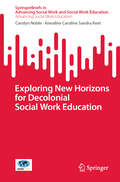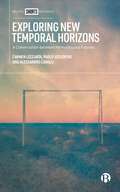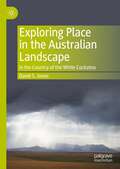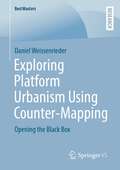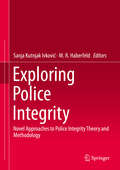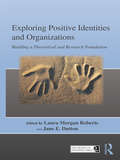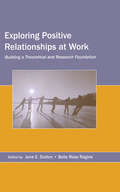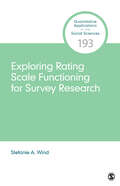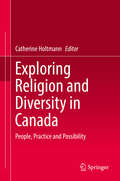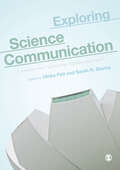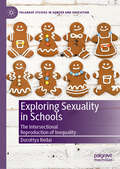- Table View
- List View
Exploring Health and Well-Being Communication in Japanese Context: Culture, Language and Multimodality (The Humanities in Asia #12)
by Keiko TsuchiyaThis book is a selection of linguistic and multimodal research on healthcare and well-being communication in Japan. This volume offers unique perspectives to the field of healthcare communication research, where studies in the West is still dominant, providing a missing piece of the whole picture. Multiculturality and multimodality in interactions in healthcare and well-being are the themes in this volume. Culture here is not limited to ethnic groups, including any sociocultural groups from different professional disciplines to atypical individuals. Two research principles are addressed: (1) multiculturality: how are inter/cross-cultural encounters or issues among different sociocultural groups addressed, and what practices are embodied in a particular sociocultural setting?, and (2) multimodality: what semiotic resources are included in the analysis, how are those data collected and transcribed? The first chapter (Tsuchiya) provides a concise overview of healthcare communication research in Japan and Europe, introducing the themes and chapters in this volume. The introductory chapter is followed by case studies in a range of research fields in healthcare and well-being in Japan: Chapter 2 (Aizaki) employs a discourse analytic approach to examine framing in a first-encounter interaction among a Japanese adult with ASD and other three non-ASD Japanese adults. The context of Nukuto's ethnographic discourse research (Chapter 3) was set in a classroom at a Japanese university, where a special education teacher was teaching crafting (monodukuri) to prospective teachers, highlighting materials as a communicative medium for grounding. Chapter 4 (Sekine, Takashima, Oka, Yano, and Suzuki) investigates how Deaf children who use Japanese Sign Language adjust their expressions of a special location in interactions with those in different age groups. Chapter 5 (Yohena) analyses discourses in Christian coaching between an American coach and a Japanese client from a cross-cultural perspective. The last two chapters are studies in hospital. Kuroshima's conversation analytic research (Chapter 6) provides a detailed description of doctors' use of patient's medical records during consultations. Chapter 7 (Tsuchiya, Nakamura and Coffey) captures a moment when a trauma team leader rejects a member's proposal in simulation in the UK and Japan. The concluding chapter (Chapter 8, Tsuchiya) recapitulates themes, theories and methods which the chapter authors employed in the previous chapters, encouraging publications in health and well-being communication research in Asia and beyond.
Exploring Heutagogy in Higher Education: Academia Meets the Zeitgeist
by Amnon Glassner Shlomo BackThis book explores heutagogy (self-determined learning) - a new approach to teaching and learning in higher education - and proposes a paradigm shift in teaching, learning, and the educational enterprise and ecosystem.The first part of the book presents the philosophical, psychological and sociological foundations of heutagogy, and describes lessons learned from prior experiences of its implementation. The second part presents a collaborative self-study of five heutagogy courses in higher education. The third discusses how the academic community can enhance the paradigm change, and compares heutagogy to similar academic approaches. The concluding chapter of the book explores the question of “what next”? and suggests some possible elaborations of heutagogy.“At the beginning, it was very difficult for me to appreciate the course’s mode of learning. All my life I had learned in a traditional manner. Occasionally I felt that I was being thrown into deep water without a lifeguard. … But as the course progressed, I succeeded in letting go of my deeply rooted habits and discovered a new learning approach, through which I found in myself a new learner…” (Student’s reflection)“...this book suggests a novel approach to learning and education and will become a widely read one.” Dr. Lisa Marie Blaschke, Carl von Ossietzky University of Oldenburg
Exploring Human Behavior and the Social Environment
by L. Allen FurrIndividuals' behaviors are a function of their interactions with the bio-psycho-social contexts in which they are situated. Consequently, in this book considerable attention is paid to the various aspects of those environments. Topics such as the effects of social class and community on behavior are given considerable attention. How individuals and groups relate to political and economic systems and bureaucracies are important themes as well.
Exploring Ibero-American Youth Cultures in the 21st Century: Creativity, Resistance and Transgression in the City
by Ricardo Campos Jordi NofreThe authors collected here address youth street cultures in different cities from the Ibero-American world, bringing together contributions on Brazil, Argentina, Mexico, Chile, Portugal, Spain, and beyond. This overseas approach bridging the European and American contexts is justified by the range of (complex) social, cultural and economic relationships that have shaped this transnational geographical space since the beginning of the colonial period. The chapters collected here focus on three key concepts—creativity, resistance and transgression—that form a threefold dispositive to locally and globally confront, contest and even fight against the hegemonic, punitive and oppressive powers (re)produced by (white, male) dominant classes of the city. The book ensures a high diversity of geographical and social/cultural research contexts by focusing on one, two or multiple spatial contexts (the public space, the street, the city) and, at the same time, by emphasizing the different economic, social, cultural, symbolic specificities of youth cultures (including gender, sexuality and race) in their particular urban contexts.
Exploring Indian Modernities: Ideas and Practices
by Leïla Choukroune Parul BhandariThis book analyses how multiple and hybrid ‘modernities’ have been shaped in colonial and postcolonial India from the lens of sociology and anthropology, literature, media and cultural studies, law and political economy. It discusses the ideas that shaped these modernities as well as the lived experience and practice of these modernities. The two broad foci in this book are: (a) The dynamism of modern institutions in India, delineating the specific ways in which ideas of modernity have come to define these institutions and how institutional innovations have shaped modernities; and (b) perspectives on everyday practices of modernities and the cultural constituents of being modern. This book provides an enriching read by bringing together original papers from diverse disciplines and from renowned as well as upcoming scholars.
Exploring Inequality: A Sociological Approach
by Jenny StuberWhile sociology is a vital and immediately relevant field of study, students sometimes feel overwhelmed by the constant attention to social problems. Instructors, may not do enough to show how the sociological perspective can empower people to work against social inequality and engage in social change. Throughout this book, the author includes examples of social activism aimed at reducing social inequality and enhancing the dignity and opportunities of diverse people. In many cases, the author uses examples of activism taking place on college campuses featuring college students as activists engaged in issues relevant to a collegiate population. Although more can always be done to spark our engagement with social issues and injustice, these examples show that ordinary college students and citizens can powerfully affect the worlds around them.
Exploring Islam beyond Orientalism and Occidentalism: Sociological Approaches (Veröffentlichungen der Sektion Religionssoziologie der Deutschen Gesellschaft für Soziologie)
by Heidemarie Winkel Christel GärtnerIslamic religion has become an object of political discourse in ways that also affects academic reflection; against this background this volume aims to provide a theoretically and empirically founded assessment of where social sciences currently stand with regard to Islam. For this purpose, the volume continues to develop the sociological knowledge of Islam that began in the 1980s. Given the Orientalism inherent in sociology, the volume focuses on Muslim knowledge systems and institutions, as well as the practice of Muslim religiosity in various social contexts stretching from Algeria and Morocco to Turkey.
Exploring Islamic Social Work: Between Community and the Common Good (Muslims in Global Societies Series #9)
by Hansjörg Schmid Amir SheikhzadeganThis open access book addresses, for the first time, Islamic social work as an emerging concept at the interface of Islamic thought and social sciences. Applying a multidisciplinary approach it explores, on the one hand, the discourse that provides religious legitimisation to social work activities and, on the other hand, case studies of practical fields of Islamic social work including educational programmes, family counselling, and resettlement of prisoners. Although in many cases, these activities are oriented towards Muslim clients, more often than not they go beyond the boundaries of Muslim communities to benefit society as a whole. Muslim actors are also starting to professionalise their services and to negotiate the ways in which they can become fully recognised service-providers within the welfare state. At a more general level, the volume also shows that in contrast to the widespread processes of secularisation of social work and its separation from religious communities, new types of activities are now emerging, which bring back to the public arena both an increased sensitivity to the religious identities of the beneficiaries and the religious motivations of the benefactors. The edited volume will be of interest to researchers in Islamic Studies, Social and Political Sciences, Social Work, and Religious Studies.This is an open access book.
Exploring LGBT Spaces and Communities: Contrasting Identities, Belongings and Wellbeing (Routledge Advances in Critical Diversities)
by Eleanor FormbyThe phrase ‘LGBT community’ is often used by policy-makers, service providers, and lesbian, gay, bisexual and trans (LGBT) people themselves, but what does it mean? What understandings and experiences does that term suggest, and ignore? Based on a UK-wide study funded by the Arts and Humanities Research Council, this book explores these questions from the perspectives of over 600 research participants. Examining ideas about community ‘ownership’; ‘difference’ and diversity; relational practices within and beyond physical spaces; imagined communities and belongings; the importance of ‘ritual’ spaces and symbols, and consequences for wellbeing, the book foregrounds the lived experience of LGBT people to offer a broad analysis of commonalities and divergences in relation to LGBT identities. Drawing on an interdisciplinary perspective grounded in international social science research, the book will appeal to students and scholars with interests in sexual and/or gender identities in the fields of community studies, cultural studies, gender studies, geography, leisure studies, politics, psychology, sexuality studies, social policy, social work, socio-legal studies, and sociology. The book also offers implications for practice, suitable for policy-maker, practitioner, and activist audiences, as well as those with a more personal interest.
Exploring Language in Global Contexts
by Jeffrey GilThis accessible and engaging textbook offers a practical approach to understanding the complexity of language by exploring language use and language learning in a wide variety of contexts. Bringing together leading specialists who are active researchers in the field of linguistics, this book introduces readers to major fields of language study by focusing on social, cultural and historical factors that show the dynamic nature of language. Topics explored include first and second language acquisition, grammar, meaning-making and pragmatics, language use and technology, language variation, and English as a global language. This book surveys major principles and shows how to apply them through structured discussion topics and activities to facilitate a greater understanding and appreciation of language. This is essential reading for undergraduate students taking courses in linguistics and language use, and a valuable resource for students of communication studies, media studies, sociology and anthropology.
Exploring Markets: A Very Brief Introduction
by Stefan KühlOrganizations construct their environments themselves. From the bewildering, chaotic array of impressions, they take those bits of information that enable them to produce such a view of the environment – one that makes it possible for them to operate in the environment with relative confidence. Thus, contrary to what traditional market research suggests, organizations do not respond objectively to existing environmental conditions, but invent, construct and create their realities themselves.The goal of exploring the environment –or, more specifically, exploring markets – is to influence this construction process through re-framing, de-generalization and hypothesis formation and thus to allow organizations to discover unusual things.
Exploring Mishnah's World(s): Social Scientific Approaches
by Calvin Goldscheider Simcha Fishbane Jack N. LightstoneThis book provides a new conceptual and methodological framework the social scientific study of Mishnah, as well as a series of case studies that apply social science perspectives to the analysis of Mishnah's evidence. The framework is one that takes full account of the historical and literary-historical issues that impinge upon the use of Mishnah for any scholarly purposes beyond philological study, including social scientific approaches to the materials. Based on the framework, each chapter undertakes, with appropriate methodological caveats, an avenue of inquiry open to the social scientist that brings to bear social scientific questions and modes of inquiry to Mishnaic evidence.
Exploring New Horizons for Decolonial Social Work Education (SpringerBriefs in Advancing Social Work and Social Work Education)
by Carolyn Noble Annaline Caroline KeetThis book presents current scholarship designed to decolonize, reform and confront the Euro-centric dominance in social work education and practice. This compact volume strings together new content from internationally recognised authors in the field of social work to address this need. Decolonising social work seeks to weaken the effect of colonialism and create opportunities to promote traditional practices in contemporary settings. Its focus is to draw attention to the effects of globalisation and the universalization of social work education, methods of practice and international development that fail to embrace and recognise local knowledges and methods by bringing new and fresh perspectives to social work. It can also be seen as a significant contribution to social work's more critical stance and long-standing struggle to challenge the hegemonic Euro-centric epistemology. With decoloniality becoming a global imperative, this collection brings together case studies from world scholars and decolonial voices in order to explore opportunities, challenges and trends to decolonize through culturally relevant curricula, including: Social Work and Decolonisation: Student Social Workers’ Understanding of the Concepts of ‘Culture’, ‘Cultural Identity’ and ‘Decolonisation’ Developing Curriculum for Criminal Justice Social Work from the Field New Directions in Trauma Work? Cultural Trauma Theory as an Instrument to Contextualise and Address Histories of Pain in Global Communities Analysing and Understanding Intersections: Using Nayak’s ‘Intersectional Model of Reflection’ in Social Work Teaching Decolonizing Social Work Education and Curriculum Utilizing Cultural Competemility and Professionalism Approach Exploring New Horizons for Decolonial Social Work Education is essential reading for practitioners, policy makers, instructors, researchers, and other social work professionals. The book may be used as a supplemental text for social work courses. The national and international focus of the volume will be highly relevant to all social work programmes across the globe.
Exploring New Temporal Horizons: A Conversation between Memories and Futures
by Carmen Leccardi Paolo Jedlowski Alessandro CavalliIn this book, leading sociologists explore how, in our digital age of connectivity, temporal acceleration and real-time simultaneity impact personal experience, relations between generations and institutional processes. The authors analyse the entanglement between past and future and explain how our ability to conceive the future is based not only upon the memory of the past, but also on forecasts about environmental crisis. Bringing memory and future studies into a unique dialogue, they highlight the crucial role of the past elaboration processes in freeing the future from the weight of trauma and renewing the ability to hope. Offering a sophisticated and innovative social theory in a burgeoning field, this is a much-needed intervention to the current ‘temporal crisis’ of social life and sociological debates.
Exploring Place in the Australian Landscape: In the Country of the White Cockatoo
by David S. JonesIncluded is a deep ethno-ecological and cross-cultural translation, that takes the reader through both the Western understanding of sense of place as well as the Australian Aboriginal understanding of Country. Both are different intellectual constructions of thoughts, values and ideologies, but which share numerous commonalities due to their archetypal meanings, feelings and values transmitted to humans.
Exploring Platform Urbanism Using Counter-Mapping: Opening the Black Box (BestMasters)
by Daniel WeissenriederIn recent years, the world witnessed the rise of big digital platforms like Amazon, Airbnb, and Uber. The emerging research field of platform urbanism focuses on these developments and concentrates on platforms and their impact on everyday life in urban space. This book introduces a novel approach to the problems of accessibility and opacity in this area of research. In order to explore the black box platform urbanism more thoroughly, different participatory mapping approaches of critical cartography are examined. The potential of so-called counter-mapping practices and related approaches for a deeper exploration of platform urbanism is discussed. The author thus establishes the nexus between participatory mapping approaches of critical cartography and their application potential for platform urbanism and provides numerous starting points for future research.
Exploring Police Integrity: Novel Approaches to Police Integrity Theory and Methodology
by M. R. Haberfeld Sanja Kutnjak IvkovićThis work provides an innovative new look at police ethics, including results from an updated version of the classic Police Integrity Questionnaire, including new social and technological advances. It aims to push the study of police research further, expanding on and testing police integrity theory and methodology, the relationship between community and integrity, and the influence of multiculturalism and globalization on policing and community attitudes.This work brings together experienced scholars who have used the police integrity theory and the accompanying methodology to measure police integrity in eleven countries, and provide advance and sophisticated explorations of the topic. Organized into three thematic sections, it explores the testing methodology for international comparisons, insights into police-community relations, and explores police subcultures.This innovative book will be of interest to researchers in criminology & criminal justice, particularly with an interest in policing, as well as related fields such as sociology, public policy, and comparative law.
Exploring Positive Identities and Organizations: Building a Theoretical and Research Foundation (Organization and Management Series)
by Jane E. Dutton Laura Morgan RobertsIn the new world of work and organizations, creating and maintaining a positive identity is consequential and challenging for individuals, for groups and for organizations. New challenges for positive identity construction and maintenance require new theory. This edited volume uncovers new topics and new theoretical approaches to identity through the specific focus on positive identities of individuals, groups, organizations and communities. This volume aims to forge new ground in identity research and organizations through a compilation of new frame-breaking chapters on positive identity written by leading identity scholars. In chapters that build theoretical and empirical bridges between identity and growth, authenticity, relationships, hope, sustainability, leadership, resilience, cooperation, and community reputation and other important variables, the authors jumpstart an exciting domain of research on new ways that work organizations are sites of and contributors to identities that are beneficial or valuable to individuals or collectives. This volume invites readers to consider, "When and how does applying a positive lens to the construct of identity generate new insights for organizational researchers?" A unique feature of this volume is that it brings together explorations of identity from multiple levels of analysis: individual, dyadic, group, organization and community. Commentary chapters integrate the chapters within each level of analysis, illuminate core themes and unearth new questions. The volume is designed to accomplish three objectives: To establish Positive Identities and Organizations as an interdisciplinary, multi-level domain of inquiry To integrate a focus on Positive Identity with existing theory and research on identity and organizations To map out a vibrant new research territory in organizational studies . This volume will appeal to an international community of scholars in Management, Psychology, and Sociology, as well as practitioners who seek to generate positive identity-related dynamics, states and outcomes in work organizations.
Exploring Positive Relationships at Work: Building a Theoretical and Research Foundation (Organization and Management Series)
by Building A TheoreticalThis edited volume brings together a select group of leading organizational scholars for the purpose of developing a foundation-setting book on positive relationships at work. Positive Relationships at Work (PRW) is a rich new interdisciplinary domain of inquiry that focuses on the generative processes, relational mechanisms and outcomes associated with positive relationships between people at work. This volume builds a solid foundation for this promising new area of scholarly inquiry and offers a multidisciplinary exploration of how relationships at work become a source of growth, vitality, learning and generative states of human and collective flourishing. A unique feature of the book is the use of a connecting commentator chapter at the end of each section. The Commentator Chapters, written by preeminent scholars, uncover and discuss integrative themes that emerge within sections. The editors approach the topic from multiple levels, each level providing critical, valuable insights into the dynamic process underlying positive relationships at work. These levels are arranged in five parts: an introduction to positive relationships at work; Individuals and Dyads; Groups and Communities; Organizations and Organizing; and a conclusion that offers an engaging invitation and multi-level map for guiding future research. This volume will appeal to academics and practitioners, as well as scholars and graduate students in organizational psychology, management, human resources, and inter-personal communications.
Exploring Rating Scale Functioning for Survey Research (Quantitative Applications in the Social Sciences)
by Stefanie A. WindItems with ordered response categories are common in survey research, such as when respondents are asked how much they agree with certain statements. But how large are the differences between categories of response, and how well do they distinguish between respondents? This volume is the first to introduce the evaluation of rating scales to an audience of survey researchers. Evaluating Rating Scale Functioning for Survey Research provides researchers with an overview of rating scale analysis along with practical guidance on how to conduct such analyses with their own survey data. Author Stefanie A. Wind presents three categories of methods: Rasch models; non-Rasch Item Response Theory (IRT) models; and non-parametric models, together with practical examples. Tutorials, datasets, and software code (R and Facets) to accompany the book are available on the book’s website.
Exploring Rating Scale Functioning for Survey Research (Quantitative Applications in the Social Sciences)
by Stefanie A. WindItems with ordered response categories are common in survey research, such as when respondents are asked how much they agree with certain statements. But how large are the differences between categories of response, and how well do they distinguish between respondents? This volume is the first to introduce the evaluation of rating scales to an audience of survey researchers. Evaluating Rating Scale Functioning for Survey Research provides researchers with an overview of rating scale analysis along with practical guidance on how to conduct such analyses with their own survey data. Author Stefanie A. Wind presents three categories of methods: Rasch models; non-Rasch Item Response Theory (IRT) models; and non-parametric models, together with practical examples. Tutorials, datasets, and software code (R and Facets) to accompany the book are available on the book’s website.
Exploring Religion and Diversity in Canada: People, Practice and Possibility
by Catherine HoltmannThis book is intended for advanced undergraduate and graduate students interested in learning about the many ways in which religious diversity is manifest in day-to-day life Canada. Each chapter addresses the challenges and opportunities associated with religious diversity in a different realm of social life from families to churches, from education to health care, and from Muslims to atheists. The contributors present key concepts, relevant statistical data and real-life stories from qualitative data. The content of the book is supplemented by links to online learning resources including videos, websites and photo essays.
Exploring Science Communication: A Science and Technology Studies Approach
by Ulrike Felt Sarah R. DaviesExploring Science Communication demonstrates how science and technology studies approaches can be explicitly integrated into effective, powerful science communication research. Through a range of case studies, from climate change and public parks to Facebook, museums, and media coverage, it helps you to understand and analyse the complex and diverse ways science and society relate in today’s knowledge intensive environments. Notable features include: A focus on showing how to bring academic STS theory into your own science communication research Coverage of a range of topics and case studies illustrating different analyses and approaches Speaks to disciplines across Media & Communication, Science & Technology Studies, Health Sciences, Environmental Sciences and related areas. With this book you will learn how science communication can be more than just about disseminating facts to the public, but actually generative, leading to new understanding, research, and practices.
Exploring Science Communication: A Science and Technology Studies Approach
by Ulrike Felt Sarah R. DaviesExploring Science Communication demonstrates how science and technology studies approaches can be explicitly integrated into effective, powerful science communication research. Through a range of case studies, from climate change and public parks to Facebook, museums, and media coverage, it helps you to understand and analyse the complex and diverse ways science and society relate in today’s knowledge intensive environments. Notable features include: A focus on showing how to bring academic STS theory into your own science communication research Coverage of a range of topics and case studies illustrating different analyses and approaches Speaks to disciplines across Media & Communication, Science & Technology Studies, Health Sciences, Environmental Sciences and related areas. With this book you will learn how science communication can be more than just about disseminating facts to the public, but actually generative, leading to new understanding, research, and practices.
Exploring Sexuality in Schools: The Intersectional Reproduction of Inequality (Palgrave Studies in Gender and Education)
by Dorottya RédaiThis book explores the place of sexuality in a Hungarian vocational school. Building upon ethnographic research using a post-structuralist and intersectional theoretical framework, the author highlights the voices of teachers and students in their everyday environment and gives them the opportunity to speak about themselves and their experiences: in doing so, addressing a significant gap in the market. The author critically discusses key issues concerning schooling and sexuality, addressing such themes as LGBTQ+ youth and teachers, institutional hierarchy, and the role of sexuality in the re/production of social inequalities through education. Through these topics, she sensitively questions what should be expected of schools in preparing their students for the wider world. The intersectional approach employed by the author will appeal to scholars in a wide variety of disciplines, from gender and sexuality studies to the sociology of education and race and ethnicity studies.
